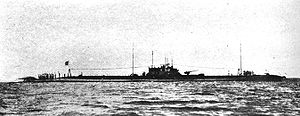 I-58 at sea
| |
| History | |
|---|---|
| Name | I-58 |
| Builder | Yokosuka Naval Arsenal, Yokosuka, Japan |
| Laid down | 3 December 1924 |
| Launched | 3 October 1925 |
| Completed | 15 May 1928 |
| Decommissioned | 1 June 1932 |
| Recommissioned | 1 December 1932 |
| Decommissioned | 1 November 1933 |
| Recommissioned | by 27 September 1934 |
| Decommissioned | after 5 October 1934 |
| Recommissioned | 1 December 1936 |
| Decommissioned | 7 January 1937 |
| Recommissioned | 1 January 1938 |
| Decommissioned | 15 December 1938 |
| Recommissioned | 15 November 1939 |
| Renamed | I-158 on 20 May 1942 |
| Fate |
|
| General characteristics | |
| Class and type | Kaidai-class submarine (KD3A Type) |
| Displacement |
|
| Length | 100 m (328 ft 1 in) |
| Beam | 8 m (26 ft 3 in) |
| Draft | 4.82 m (15 ft 10 in) |
| Installed power |
|
| Propulsion | |
| Speed |
|
| Range |
|
| Test depth | 60 m (197 ft) |
| Complement | 60 |
| Armament |
|
I-58, later I-158, was an Imperial Japanese Navy Kaidai-class cruiser submarine of the KD3A sub-class commissioned in 1928. During World War II, she supported Japanese forces during the invasion of Malaya in December 1941 and was instrumental in tracking Force Z, the two British capital ships that attempted to intercept the Japanese invasion forces, so they could be sunk by torpedo bombers. She sank four Dutch merchant ships in early 1942 during the Dutch East Indies campaign and then was transferred to the Central Pacific in May 1942 to support the fleet during the Battle of Midway in early June 1942. Upon her return to Japan in July 1942, she became a training ship until early 1945 when she was modified to serve as a carrier for kaiten manned suicide attack torpedoes. She surrendered to the Allies at the end of the war and was scuttled in 1946.